If you have a plumeria that is not looking its best, you may be wondering why its leaves are curling. There are a few reasons why this may be happening, and fortunately, there are also a few things you can do to fix it. Keep reading to learn more about why your plumeria leaves may be curling and how you can help your plant to look its best.
Causes of Plumeria Leaves Curling
The leaves of plumeria (Plumeria alba) may curl for several reasons, including environmental stress, pests, and disease.
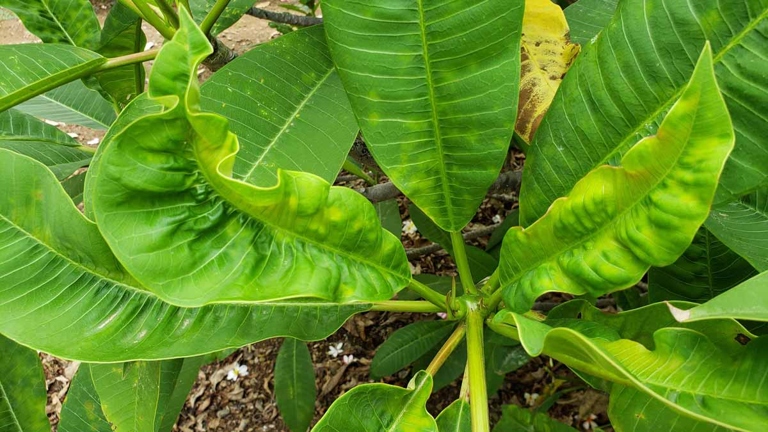
If the plant is not receiving enough water, the leaves will also curl in an attempt to conserve moisture. Environmental stressors such as too much sun, wind, or heat can cause the leaves of plumeria to curl.
Pests such as aphids, scale, and mealybugs can also cause plumeria leaves to curl. These pests suck the sap from the leaves, causing them to wilt and curl.
Diseases such as plumeria rust and botrytis can also cause leaves to curl. Botrytis is a fungal disease that causes gray or brown spots on the leaves, which can also cause the leaves to curl. Plumeria rust is a fungal disease that causes yellow or orange spots on the leaves, which eventually turn brown and curl.
Under-watering
Allow the top inch of soil to dry out between watering. If your plumeria is kept indoors, make sure to place it near a humidifier or open window. When plumeria are under-watered, their leaves will begin to curl in an effort to conserve water. If your plumeria leaves are curling, it’s likely due to under-watering. Plumeria are native to tropical climates and require regular watering to thrive. Water until the soil is moist, but not soggy. Plumeria also benefit from regular misting, especially during the dry winter months. If you see your plumeria leaves curling, water your plant immediately. With proper care, your plumeria will soon recover and its leaves will uncurl.
Overfeeding with Fertilizer
When it comes to fertilizer, more is not always better. If you’re noticing that your plumeria leaves are curling, it could be a sign that you’re overfeeding your plant with fertilizer. In fact, overfeeding your plumeria with fertilizer can lead to a number of problems, including leaf curl.
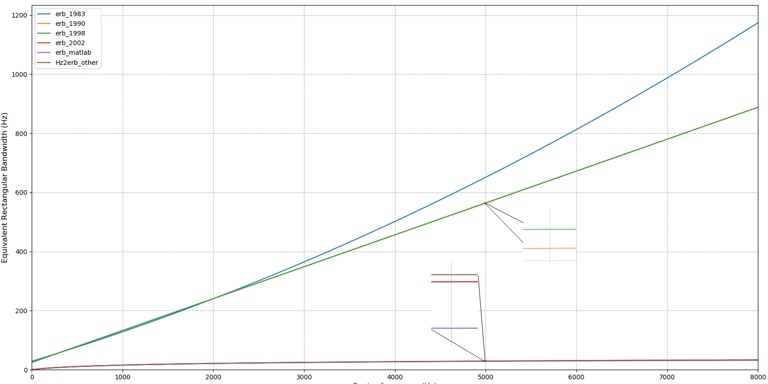
If it does, great! Once you’ve cut back, be sure to monitor your plant closely to see if the leaf curl improves. If you suspect you’re overfeeding your plumeria, the first thing to do is cut back on the amount of fertilizer you’re using. If not, it’s possible that your plumeria is suffering from a nutrient deficiency, in which case you’ll need to adjust your fertilizer accordingly.
As a general rule of thumb, it’s best to err on the side of underfeeding your plumeria rather than overfeeding it. This will help ensure that your plant stays healthy and happy for years to come.
Nutrient Deficiency
Plumeria are heavy feeders and require regular fertilization to stay healthy. Without enough nutrients, the leaves will begin to curl and eventually drop off. If your plumeria leaves are curling, it’s likely due to a nutrient deficiency.
If the soil is too sandy or clay-like, it may not be able to hold onto nutrients as well. Adding organic matter to the soil can help improve its ability to retain nutrients. There are a few ways to fix a nutrient deficiency. First, check the soil to see if it needs to be amended.
These are the three main nutrients that plumeria need. If the soil seems fine, the next step is to fertilize your plumeria. Use a fertilizer high in nitrogen, phosphorus, and potassium. Apply the fertilizer according to the package directions, and be sure to water it in well.
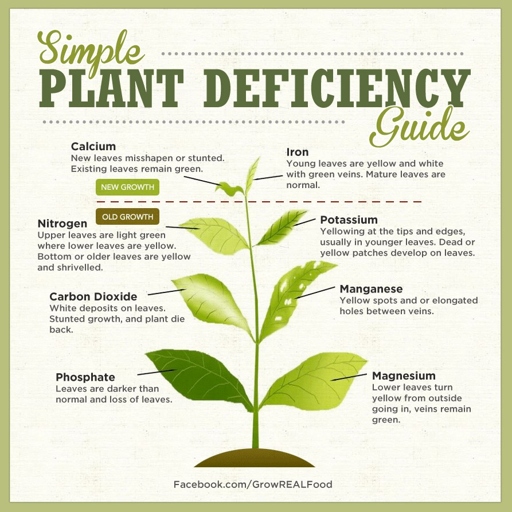
With regular fertilization and proper care, your plumeria should soon be back to its healthy self!
Temperature Stress
This can happen if the leaves are exposed to direct sunlight or if the temperature in your home fluctuates. The leaves of your plumeria can become damaged when the temperature changes too rapidly. If the temperature stress is severe, the leaves may turn brown and fall off. If you notice your plumeria leaves curling, it could be a sign of temperature stress. This is a common problem in areas with hot summers and cold winters.
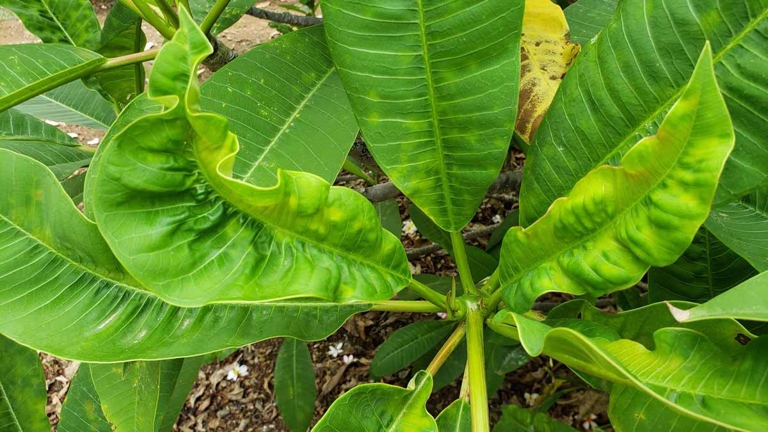
Second, try to keep the temperature around the plant consistent. Plumeria prefer to be kept moist, but not soggy. Third, if the leaves are exposed to direct sunlight, try to provide some shade. This will help the plant focus its energy on new growth. First, make sure the plant is getting enough water. There are a few things you can do to help your plumeria recover from temperature stress. If it is too hot or too cold, the leaves will curl. You can do this by moving the plant to a shady spot or by using a sheer curtain. Finally, if the temperature stress is severe, you may need to prune the damaged leaves.
Roots Rotting from Over-Watering
Over-watering is a common problem with plumeria, and it can lead to a number of problems, including root rot. If you notice that the leaves on your plumeria are curling, it could be a sign that the roots are rotting from too much water.
Let the soil dry out completely before watering again, and be sure to drainage holes in the pot so that excess water can drain away. If you think your plumeria might be over-watered, the first thing you should do is check the soil. If it’s soggy or wet, that’s a sure sign that you’re giving your plant too much water.

If the leaves are still curling after you’ve adjusted your watering schedule, it’s possible that the root rot has already set in. In this case, you’ll need to repot your plumeria in fresh, dry soil. With proper care, your plumeria should recover and the leaves will uncurl. Be sure to remove any affected roots, and don’t water the plant until the soil is dry.
Water quality
If you notice your plumeria leaves curling, it could be a sign of poor water quality. To fix the problem, you’ll need to adjust your watering habits and make sure you’re using the right type of water. The leaves may be curling due to a lack of nutrients, or because the water is too acidic or alkaline.
If you’re using tap water, it may be high in chlorine or other chemicals that can harm your plumeria. Try using filtered or distilled water instead. You should also let the water sit for a day or two before using it, so the chemicals have time to evaporate.
It’s also important to water your plumeria regularly, as the plant needs a lot of moisture to stay healthy. However, you should avoid overwatering, as this can also cause the leaves to curl. Allow the soil to dry out slightly between watering, and make sure the pot has drainage holes so the roots don’t become waterlogged.

If you suspect the problem is a lack of nutrients, you can try feeding your plumeria with a balanced fertilizer. Apply the fertilizer according to the package directions, and be sure to water it in well. With proper care, your plumeria should soon be back to its healthy self.
Excessive Sunlight
Plumeria leaves can curl for a variety of reasons, but one of the most common is excessive sunlight. If your plumeria is getting too much sun, the leaves will start to curl as a way to protect themselves from the harsh rays.
If you live in an area with very strong sunlight, you may need to provide some shade for your plant during the hottest hours of the day. To fix this, simply move your plumeria to a spot that gets less sun.
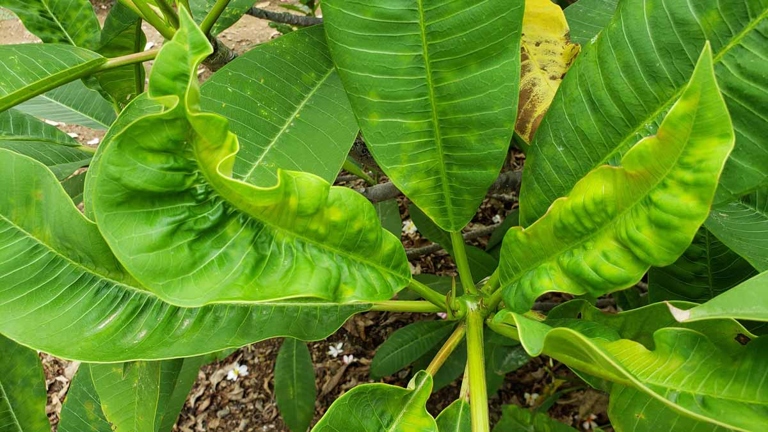
Leaves that are curled due to excessive sunlight will usually start to uncurl within a few days after being moved to a more shady spot. However, if the leaves are still curled after a week or so, it’s possible that the damage is irreversible and the leaves will remain curled permanently.
Lack of Light
Plumeria need at least six hours of sunlight per day, so if they’re not getting enough, their leaves will start to curl. If your plumeria leaves are curling, it could be a lack of light.

If that doesn’t work, try giving them artificial light with a grow light. First, move your plumeria to a sunnier spot. Finally, make sure you’re not over-watering your plumeria. There are a few things you can do to fix the problem. Too much water can also cause leaves to curl.
Diseases of Plumeria
If you’re noticing your plumeria leaves curling, it could be a sign of one of several diseases. These include plumeria rust, plumeria mosaic virus, and plumeria leaf spot.
You can also try spraying the plant with a fungicide. To treat it, remove affected leaves and dispose of them. Plumeria rust is a fungal disease that causes orange or brown spots on the leaves, as well as leaf curling.
There is no cure for this virus, so the best course of action is to remove affected leaves and dispose of them. Plumeria mosaic virus is another common disease that affects plumeria plants. Symptoms include yellow or white mottling on the leaves, as well as leaf curling.
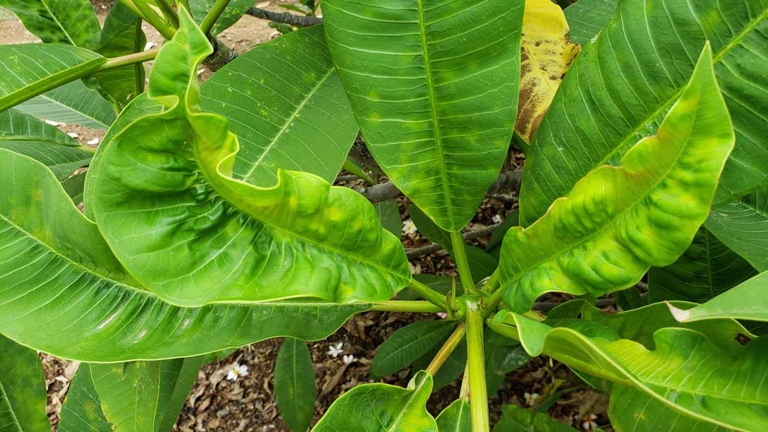
It can also cause leaf curling. You can also try spraying the plant with a fungicide. Finally, plumeria leaf spot is a fungal disease that causes small, dark spots on the leaves. To treat it, remove affected leaves and dispose of them.
Insect Infestation
These pests can damage the leaves, stems, and flowers of your plant, causing them to curl and discolor. If you notice your plumeria leaves curling, it could be a sign of an insect infestation.

Then, apply an insecticide specifically designed for plumeria plants. To get rid of insects, start by spraying your plumeria with water to dislodge them. Be sure to follow the instructions on the label carefully.
You can also take preventive measures to keep insects from infesting your plumeria in the first place. These include keeping the area around your plant clean and free of debris, and regularly inspecting your plant for signs of pests.
Low Humidity
If the air is too dry, the leaves will curl in an attempt to conserve moisture. If you live in a dry climate, you may notice your plumeria leaves curling. This is because plumeria plants need high humidity to thrive.

There are a few things you can do to increase the humidity around your plumeria plant. You can also mist your plant regularly, or use a humidifier. This will help to increase the humidity by evaporating water from the stones. First, try placing it on a pebble tray.
With a little extra care, your plumeria plant will soon be thriving in its new environment.
Plumeria Leaves Curling After Repotting
If your plumeria leaves are curling, it could be a sign that the plant needs to be repotted. Curling leaves can also be caused by too much or too little water, or by a lack of nutrients.

Be sure to use a well-draining potting mix, and water the plant thoroughly before repotting. If you think your plumeria needs to be repotted, choose a new pot that is only slightly larger than the current one.
Try using a fertilizer formulated for plumeria plants. If the leaves are still curling, it could be a sign of a nutrient deficiency. Water the plant when the top inch of soil is dry. If curling leaves are caused by too much or too little water, adjust your watering schedule accordingly.
Key Takeaways
Here are the most common causes of leaf curling in plumeria plants: If your plumeria leaves are curling, it could be due to a number of reasons.
Too Much Water 1.
This is because the plant is getting too much water and the roots are not able to absorb it all. To fix this, cut back on watering and allow the soil to dry out between watering. If you’re watering your plumeria plant too frequently, the leaves may start to curl.
Too Much Sun 2.
To fix this, move the plant to a location that gets less sun. If your plumeria plant is getting too much sun, the leaves may also start to curl. This is because the leaves are getting sunburned.
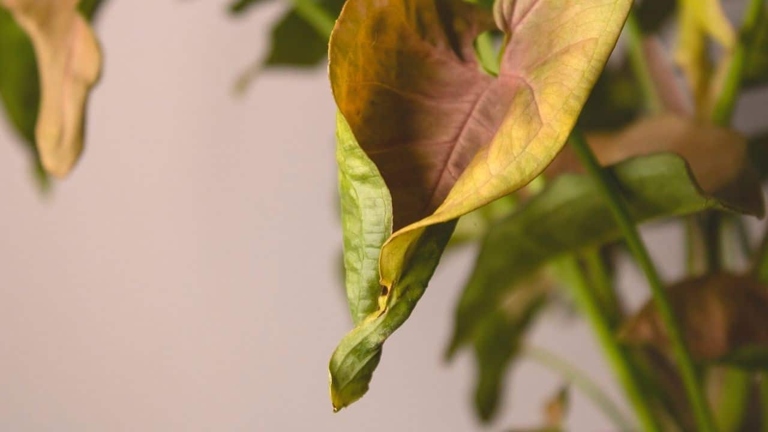
Pests 3.
This is because the pests are feeding on the leaves and causing them to curl. If your plumeria plant is infested with pests, such as aphids, the leaves may start to curl. To fix this, treat the plant with an insecticide.
Disease 4.
If your plumeria plant is infected with a disease, such as powdery mildew, the leaves may start to curl. To fix this, treat the plant with a fungicide.
By following these tips, you can fix the leaf curling problem in your plumeria plant.
Frequently Asked Questions
1. Why are my plumeria leaves curling?
There are a few reasons why your plumeria leaves may be curling. It could be due to too much sun, not enough water, or a nutrient deficiency.
2. What can I do to fix it?
If your plumeria leaves are curling due to too much sun, try moving your plant to a shadier spot. If it’s not getting enough water, make sure to water it more frequently. If a nutrient deficiency is the problem, you can try fertilizing your plant.
3. How do I know if my plumeria is getting too much sun?
If your plumeria leaves are turning yellow or brown and curling up, it’s likely getting too much sun.
4. How often should I water my plumeria?
Your plumeria should be watered about once a week, or when the soil is dry to the touch.
5. What kind of fertilizer should I use for my plumeria?
A fertilizer with a high phosphorus content is best for plumeria plants.
Final thoughts
If your plumeria leaves are curling, it is likely due to one of three reasons: too much sun, too little water, or pests. The best way to fix the problem is to figure out which of these is the cause and then take the appropriate action. If you give your plumeria the right amount of sun and water, it should start to look better in no time.
